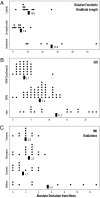Development and the evolvability of human limbs
- PMID: 20133636
- PMCID: PMC2840520
- DOI: 10.1073/pnas.0911856107
Development and the evolvability of human limbs
Abstract
The long legs and short arms of humans are distinctive for a primate, the result of selection acting in opposite directions on each limb at different points in our evolutionary history. This mosaic pattern challenges our understanding of the relationship of development and evolvability because limbs are serially homologous and genetic correlations should act as a significant constraint on their independent evolution. Here we test a developmental model of limb covariation in anthropoid primates and demonstrate that both humans and apes exhibit significantly reduced integration between limbs when compared to quadrupedal monkeys. This result indicates that fossil hominins likely escaped constraints on independent limb variation via reductions to genetic pleiotropy in an ape-like last common ancestor (LCA). This critical change in integration among hominoids, which is reflected in macroevolutionary differences in the disparity between limb lengths, facilitated selection for modern human limb proportions and demonstrates how development helps shape evolutionary change.
Conflict of interest statement
The authors declare no conflict of interest.
Figures



Similar articles
-
Ecomorphological specialization leads to loss of evolvability in primate limbs.Evolution. 2020 Apr;74(4):702-715. doi: 10.1111/evo.13900. Epub 2020 Jan 9. Evolution. 2020. PMID: 31849049
-
Morphological integration and evolutionary potential of the primate shoulder: Variation among taxa and implications for genetic covariances with the basicranium, pelvis, and arm.J Hum Evol. 2022 Aug;169:103221. doi: 10.1016/j.jhevol.2022.103221. Epub 2022 Jun 27. J Hum Evol. 2022. PMID: 35772227
-
Serial homology and the evolution of mammalian limb covariation structure.Evolution. 2005 Dec;59(12):2691-704. Evolution. 2005. PMID: 16526515
-
Fossil apes and human evolution.Science. 2021 May 7;372(6542):eabb4363. doi: 10.1126/science.abb4363. Epub 2021 May 6. Science. 2021. PMID: 33958446 Review.
-
Last Common Ancestor of Apes and Humans: Morphology and Environment.Folia Primatol (Basel). 2020;91(2):122-148. doi: 10.1159/000501557. Epub 2019 Sep 18. Folia Primatol (Basel). 2020. PMID: 31533109 Review.
Cited by
-
Evolution of the locomotor skeleton in Anolis lizards reflects the interplay between ecological opportunity and phylogenetic inertia.Nat Commun. 2021 Mar 9;12(1):1525. doi: 10.1038/s41467-021-21757-5. Nat Commun. 2021. PMID: 33750763 Free PMC article.
-
Evolvability: filling the explanatory gap between adaptedness and the long-term mathematical conception of fitness.Biol Philos. 2024;39(4):15. doi: 10.1007/s10539-024-09951-3. Epub 2024 Jul 16. Biol Philos. 2024. PMID: 39021712 Free PMC article.
-
Human shoulder development is adapted to obstetrical constraints.Proc Natl Acad Sci U S A. 2022 Apr 19;119(16):e2114935119. doi: 10.1073/pnas.2114935119. Epub 2022 Apr 11. Proc Natl Acad Sci U S A. 2022. PMID: 35412896 Free PMC article.
-
Genomic correlates of relationship QTL involved in fore- versus hind limb divergence in mice.Genome Biol Evol. 2013;5(10):1926-36. doi: 10.1093/gbe/evt144. Genome Biol Evol. 2013. PMID: 24065733 Free PMC article.
-
The work to swing limbs in humans versus chimpanzees and its relation to the metabolic cost of walking.Sci Rep. 2024 Apr 18;14(1):8970. doi: 10.1038/s41598-024-59171-8. Sci Rep. 2024. PMID: 38637567 Free PMC article.
References
-
- Capdevila J, Belmonte JCI. Perspectives on the evolutionary origin of tetrapod limbs. Mol Dev Evol. 2000;288:287–303. - PubMed
-
- Coates MI, Jeffery JE, Ruta M. Fins to limbs: What the fossils say. Evol Dev. 2002;4:390–401. - PubMed
-
- Van Valen LM. Serial homology: The crests and cusps of mammalian teeth. Acta Palaeontol Pol. 1994;38:1451–1458.
-
- Ruvinsky I, Gibson-Brown JJ. Genetic and developmental bases of serial homology in vertebrate limb evolution. Development. 2000;127:5233–5244. - PubMed
Publication types
MeSH terms
LinkOut - more resources
Full Text Sources
Research Materials
Miscellaneous

